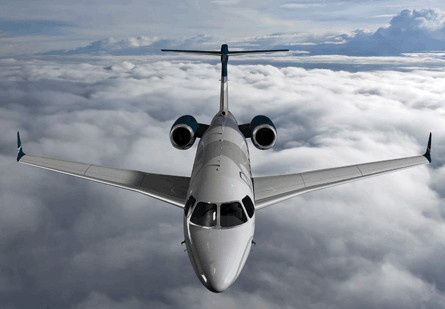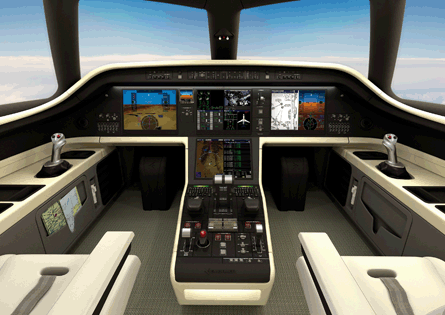Embraer has chosen to use a side-stick cockpit controller for the Legacy 450/500, but the throttles will be back-driven. Pictured is the 500 cockpit
With its Legacy 450/500 executive jets, Embraer is promising to develop and field a full three-axis closed-loop fly-by-wire controlled aircraft.
While a clean-sheet aircraft with FBW is not revolutionary, Embraer plans to bring the technology to a jet priced at one-half to one-third the cost of the only current FBW business jet, the Dassault Falcon 7X.
FBW controls on jet aircraft are not a recent development. The defence sector led the way in the 1970s with the US Air Force and General Dynamics developing and fielded the F-16. In the civil sector, Airbus has long been at the forefront of FBW development, selling thousands of its FBW A320 family.
 |
|---|
© EmbraerAt low speeds, Embraer is investigating the addition of a trim control speed concept to give the Legacy apparent speed stability |
But FBW applications in the business sector have lagged defence and civil applications by a good margin. The reasons are several, with cost and market acceptance perhaps being the major obstacles. When it was launched, Bombardier's large-cabin, long-range Global Express was to be the first FBW business jet. When the business jet was certificated, however, Bombardier had reverted to conventional flight controls.
It should be no surprise that the first FBW business jet, the Falcon 7X, was developed by a firm with much defence FBW experience.
BASIC FLY-BY-WIRE
FBW control schemes can offer many benefits, including increased performance and comfort, enhanced safety and reduced pilot workload. Whether all these benefits are realised depends heavily on how FBW is employed.
The simplest FBW systems are open loop, there being no control-feed back loop. The accelerator pedal in many automobiles is connected to the engine not with a mechanical linkage, but with a by-wire system. How far the pedal is pushed signals how high the engine is to rev. At this level, it is an open-loop system with speed controlled by the foot. Engaging the cruise control to maintain a desired speed closes the loop. Engine RPM is modulated by a feedback circuit to keep a steady speed.
Many aircraft FBW applications are open loop - the brake-by-wire systems of the Embraer Phenom 100/300, for example. While the system has an anti-skid feature, brake pedal displacement does not set a deceleration rate - rather, it only determines how much pressure is applied to the brake pads.
Embraer's first major FBW application on a civil aircraft is the flight control system in its E-Jets. Controls are digital in pitch (elevator) and yaw (rudder) axis. In the roll axis, spoilers are digital, but ailerons are conventional. While the system architecture is digital, actual pitch control is for the most part an open-loop affair. Embraer's goal in the E-Jet's pitch axis was to "digitise" a conventional pitch control system. Yoke displacement and aircraft speed are the primary inputs to a "look-up" table that determines how much the elevator is to be displaced. Only when angle-of-attack approaches a critical level does the control loop close on elevator displacement to prevent a stall. FBW spoiler control in the Phenom 300 and new Boeing 747-8 are also two examples of open-loop FBW control systems.
LEGACY IMPLEMENTATION
Embraer's control law design philosophy is to have "soft limits" that define the edges of the normal flight envelope and "hard limits" that define the edges of the limit flight envelope. Control laws in the normal flight envelope restrict pitch attitude to +30°/-15°, limit bank angle to 33° and speeds to a range between the maximum operating speed (VMO) and a minimum speed 10% above the stall speed (1.1 VSTALL).
These soft limits can be exceeded by holding the side stick out of neutral, but releasing the stick will automatically return the aircraft to the normal flight envelope. The limit flight envelope is defined not by pre-determined pitch/roll attitude limits, but rather by actual structural and controllability limits. Any combination of pitch and roll attitude is available as long as no limit is exceeded.
 |
|---|
© Embraer |
Embraer is working to define specific control laws for the Legacy 450/500. While in Brazil to fly the Phenom 300 in April, I had a chance to fly Embraer's flight-control development simulator and get a first look at the fruits of its efforts. Embraer has chosen to use a sidestick cockpit controller, but unlike Airbus, the throttles will be back-driven just as they are on Boeing aircraft.
The sidestick will be a displacement controller with a fixed force gradient in each axis. The two sidesticks are not interconnected, their inputs are summed to send a signal to the flight controls. In the event of a dual input, visual, aural and tactile warnings are provided. Yaw axis is controlled by a spring-loaded interconnected dual rudder pedal system.
Closed-loop FBW control systems seek to normalise aircraft response to pilot inputs such that regardless of the flight conditions, a set stick input will always generate the same aircraft response. In a conventional aircraft, moving the elevator merely changes the AOA on the horizontal stabiliser, which should change the aircraft's pitch attitude.
How much it changes is dependent on several factors including speed, altitude, gross weight and centre of gravity. The challenge for flight-control law developers is to pick a control scheme that mimics a conventional control system while still providing a normalised response. While in up and away conditions, not in take-off or landing configuration, longitudinal control stick displacement commands a rate of flightpath angle (gamma) change (gamma dot).
Broadly speaking, Embraer's gamma dot control is analogous to pitch rate (theta dot) control, used at slow speeds in Airbus civil aircraft. At higher speeds however, Airbus longitudinal (pitch) control shifts to a g command system.
While it might be preferable to have a single pitch control law over the entire speed range, flight experience has shown g command systems to be overly sensitive at low speeds, guiding the adaptation of a blended g command and theta dot longitudinal control scheme. Given Embraer's use of a single pitch control scheme over the entire speed range, it will be interesting to see how the gamma dot command system works at high speeds.
Conventional pitch controls only move the elevator, which generally gives conventional aircraft a level of speed stability. From a trimmed condition, advancing or retarding the power will cause the aircraft to climb or descend at the trimmed speed. Control schemes such as g command and theta dot/gamma dot will not by design exhibit speed stability. Whether speed stability is desirable or not is a matter of debate - Airbus does not include it while Boeing provides apparent speed stability in its 777.
At low speeds Embraer is investigating the addition of a trim control speed concept to give the Legacy apparent speed stability. My brief exposure to it was in a landing configuration, and it made the Legacy feel more like a conventional aircraft.
In a conventional aircraft the lateral-directional (roll-yaw) axes are interconnected, a fact to which any pilot experiencing a Dutch roll can attest. In a FBW control system they can be decoupled if desired. Airbus and Embraer have both decoupled the roll and yaw axes, and made the sidestick a roll rate controller. Lateral stick displacement only rolls the aircraft, without the adverse yawing found in a conventional aircraft.
Returning the stick to the centre position commands zero roll rate, and depending on the manufacturer's specific scheme limits, keeps the aircraft at a set bank angle. Roll axis control in the 777 is more like that of a conventional aircraft, lateral yoke displacement commanding aileron and roll spoiler deflection not a desired roll rate. Having flown the 777 and several Airbus aircraft, both roll control schemes work well when in an up and away condition.
With the advent of features such as yaw dampers and aileron-rudder interconnects, rudder use in conventional large aircraft is mostly limited to the take-off and landing phases of flight. In a conventional aircraft, side slip usually generates a roll in the direction of the rudder pedal input, termed roll due to yaw. With an FBW control scheme the roll and yaw axes again can be decoupled: rudder displacement only generating a wings level side slip.
Pilots, however, do expect some roll due to yaw, and some limited apparent roll due to yaw effects can be built into an FBW control system. The need for some roll due to yaw is most apparent in an engine failure scenario. Allowing the wing corresponding to the failed engine to drop is a good alert to the developing emergency situation. Airbus aircraft drop the dead engine's wing. Embraer is still fine-tuning its lateral-directional control laws, but an engine failure causes a gentle wings level turn (skid).
FBW BENEFITS
FBW controls schemes offer many benefits, the foremost perhaps being safety. Control laws can be designed so the pilot cannot exceed the authorised flight envelope, no more overspeed or over-g events. Embraer's pitch axis system limits gs at higher speeds transitioning to an AOA limiter at slower speeds.
The AOA limiter function negates the need for a stick pusher, as the aircraft cannot be pulled to a dangerous AOA. The g and AOA limiting feature also allows the pilot maximum performance in avoiding controlled flight into terrain and in windshear recovery manoeuvres.
 |
|---|
© Embraer |
Finally, a docile response to an engine failure can greatly stack the odds in the pilot's favour in a very demanding situation.
FBW control schemes also enhance aircraft performance. Automatic limiting features of Embraer's FBW control scheme should allow for a lighter aircraft as safety margins can be reduced. This is also applicable to the yaw axis, as sideslip limitations can reduce vertical tail loads and allow for a lower structural weight.
While not employed by Embraer for the Legacy, active load alleviation systems found on many large aircraft can further reduce structural weight. Reduced structural weight means less drag, while overspeed limiting features allow for cruise at speeds near the maximum design speeds VD/MD. AOA protections enhance runway performance as take-off and approach speeds can be flown closer to the actual stall speed.
FBW control systems can also enhance passenger comfort while reducing pilot workload. Transient aircraft motion due to power and configuration changes can be written out of the equation, a boon to both pilot and passenger. Uncommanded aircraft motions due to turbulence can be rapidly dampened out without reducing aircraft responsiveness to pilot control inputs. Lastly, FBW control systems can deliver an aircraft with predictable responses to control inputs throughout the entire flight envelope.
MEASURED PROGRESSION
Over the years Embraer has gained FBW experience in a measured step-by-step manner. Development of brake-by-wire systems and digital spoiler, rudder and pitch control systems in the E-Jets has given Embraer a foundation upon which to tackle a far greater challenge, the FBW Legacy 450/500 models.
Based on my brief flight in Embraer's flight-control development simulator, it appears to have a handle on the magnitude of the task, and is well on its way to developing a flight-control system for the prototype Legacy 500's first flight.
Promising simulation results, however, do not always pan out in real flight and Embraer has a long road ahead to certificate the FBW Legacy. If the past is prologue, Embraer will no doubt deliver a very capable midsized business jet with fine flying qualities.
Source: Flight International




















